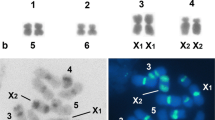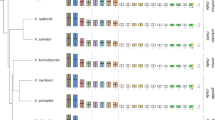Abstract
The chromosome complement in the human bed bug, Cimex lectularius Linn., is 26+X1X2Y in the male and 26+X1X1X2X2 in the female. However, a population from Cairo, Egypt has 4 supernumerary X chromosomes. In the hybrid between the Berkeley population (with no supernumeraries) and the Cairo population (with 4 supernumeraries), the behavior of supernumeraries was observed during embryogenesis and oogenesis as well as spermatogenesis.
In embryogenesis the transmission of supernumeraries was quite regular. However, one chromosome may sometimes be eliminated early in the germ line. This abnormality could induce the variations in chromosome number encountered in later stages. In the first meiotic division, some of the supernumeraries were nondisjunctional. Moreover, in the second division, some supernumeraries were eliminated. These results show that there is a tendency towards a decrease in the number of supernumeraries in the hybrids.
Although the supernumeraries behave like X chromosomes, they seem not to be important for sex determination and appear to be largely or entirely inert genetically. Supernumeraries in the bed bug originate from small fragments caused by structural rearrangement. They are increased by an accumulation mechanism. Supernumeraries in the bed bug appear to be of relatively recent origin. The phylogenetic sequence in their development was probably from none to a stabilized number of four in the Old World. Then the supernumeraries were lost in two specialized lines, Cimex columbarius Jenyns on domestic birds in Europe and Cimex lectularius Linn. on man in the Western Hemisphere.
Similar content being viewed by others
References
Darlington, C. D.: The genetical and mechanical properties of the sex chromosomes. V. Cimex and the Heteroptera. J. Genet. 39, 351–361 (1939);- Fortieth Annual Report of the John Innes Horticultural Institution 1950, 30 p.; - Chromosome botany. London: Allen & Unwin Ltd. 1956.
McKean, H. E.: Inheritance of supernumerary X-chromosomes in Cimex. In: R. L. Usinger, Monograph of Cimicidae (Hemiptera — Heteroptera). Thomas Say Foundation, Entomol. Soc. Amer. pp. 283–245 (1966).
Müntzing, A.: Accessory chromosomes in rye populations from Turkey and Afghanistan. Hereditas (Lund) 36, 507–509 (1950); - A new category of chromosomes. Proc. X. Internat. Congr. Genet. 1, 443–467 (1958); - Genetical research. Stockholm: LTs Förlag 1961.
Naville, A., et J. de Beaumont: Recherches sur les chromosomes des Neuroptéres. Arch. Anat. micr. Morph. exp. 29, 199–243 (1933).
Nur, U.: A supernumerary chromosome with an accumulation mechanism in the lecanoid genetic system. Chromosoma (Berl.) 13, 249–271 (1962).
Östergren, G.: Parasitic nature of extra chromosome fragments. Bot. Not. (Lund) 1945, 157–163 (1945).
Slack, H. D.: Structural hybridity in Cimex L. Chromosoma (Berl.) 1, 104–118 (1939).
Ueshima, N.: Chromosome behavior of the Cimex pilosellus complex (Cimicidae: Hemiptera). Chromosoma (Berl.) 14, 511–521 (1963); - Experiments on reproductive isolation in Cimex lectularius and Cimex columbarius (Hemiptera:Cimicidae). Pan-Pac. Entomol. 40, 47–53 (1964); - Cytology and cytogenetics. In: R. L. Usinger, Monograph of Cimicidae (Hemiptera — Heteroptera). Thomas Say Foundation, Entomol. Soc. Amer. pp. 183–237 (1966).
Usinger, R. L.: Monograph of Cimicidae (Hemiptera — Heteroptera). Thomas Say Foundation, Entomol. Soc. Amer. pp. 1–2 (1966).
-, and D. Povolny: The discovery of a possibly aboriginal population of the bed bug (Cimex lectularius L.). Acta Mus. Moraviae, Sci. Nat. 51 (in press, 1966).
White, M. J. D.: Animal cytology and evolution, 2nd. ed. Cambridge: Cambridge University Press 1954.
Wilson, E. B.: Notes on the chromosome groups of Metapodius and Banasa. Biol. Bull. 12, 303–313 (1907); - Studies on chromosomes. VI. A new type of chromosome combination in Metapodius. J. exp. Zool. 9, 53–78 (1910).
Author information
Authors and Affiliations
Additional information
This study was carried out under U.S. Public Health Service Grant (GM-13197).
Rights and permissions
About this article
Cite this article
Ueshima, N. Supernumerary chromosomes in the human bed bug, Cimex lectularius Linn. (Cimicidae:Hemiptera). Chromosoma 20, 311–331 (1967). https://doi.org/10.1007/BF00326188
Received:
Issue Date:
DOI: https://doi.org/10.1007/BF00326188




